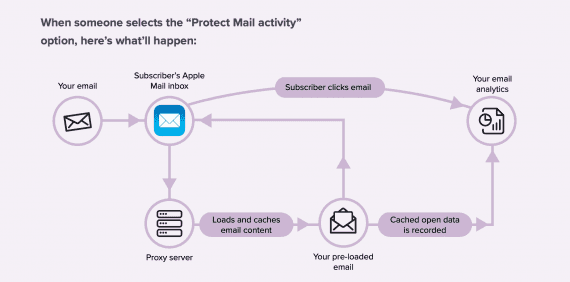As early as September 2021, Apple’s mobile email apps may hide a recipient’s internet protocol address, making it difficult or impossible to measure open rates and track user behavior.
Apple announced its new email privacy initiative on June 7, 2021, as part of its forthcoming iOS 15 operating system.
“Privacy has been central to our work at Apple from the very beginning,” said Craig Federighi, Apple’s senior vice president of software engineering. “Every year, we push ourselves to develop new technology to help users take more control of their data and make informed decisions about whom they share it with.”
Since then, email experts have sought to understand how this change will impact marketing, given that Apple’s email applications combined had about 48% of the total global email client market as of July 2021, according to Litmus.
Clicks and Conversions
Most email service providers embed tracking pixels in email messages. These pixels help identify when a recipient has opened an email.
For users who choose to “Protect Mail Activity” in iOS 15, Apple will use a caching server to open emails and provide a general IP address back to the email service providers rather than a specific one that could identify a recipient’s location.
This caching will dramatically inflate open rates, perhaps even sending them to 100% for some businesses.
Email messages will be routed through a caching or proxy server, as shown in this diagram from Litmus.
Even if some users choose not to hide their IP or activity, it would be difficult to differentiate them, thus making open rates far less meaningful.
This change will impact how some email marketing campaigns are run. But by no means is it the end of email effectiveness.
“As marketers, we looked at the open rate, but it wasn’t the most critical metric,” said Melissa Sargeant, chief marketing officer at Litmus, a provider of email tools and services.
In place of open rates, marketers will likely use clicks and conversions. Both will remain available after iOS 15 is released, according to Sargeant.
Moreover, clicks and conversions may be more meaningful than opens and might lead to better email marketing.
To prepare for iOS 15, marketers should look at clicks and conversions now.
Testing
“You have to think of this change in Apple Mail beyond just the open rate in terms of what it will influence in an email marketing program. For example, it’s going to impact A/B tests that use open rates to determine the winner,” said Sargeant.
In hindsight, using the open rate in an A/B test was probably not the best choice anyway. The purpose of most email campaigns is clicks and conversions, not opens.
Here is an extreme (and unlikely) scenario to make the point. Imagine a business that sells framed wildlife photography. You could build a subject line test with the following two options.
- “Amazing Animal Portraits”
- “Nude Photos Enclosed”
Measuring the open rate here is useless. For some audiences, “Nude Photos Enclosed” would significantly outperform the alternative. But those folks would not likely click when they open the message and find images of squirrels and deer.
Thus iOS 15’s email apps might actually be for the better, especially for ecommerce.
Automated Workflows
Many automated email workflows include open rates.
Marketers that use open rate as a trigger in a nurturing campaign or some other form of lifecycle marketing should revisit those campaigns soon, ideally before iOS 15 is released.
Even if the open rate is not a trigger, it could impact a segment or cohort that the workflow uses, such as a segment that includes a last open date.
This is especially important for list hygiene workflows since the inflated open rate could make unengaged recipients appear active.
Dynamic Content
Inflated open rates and the loss of IP addresses will also impact some forms of email personalization and localization, according to Sargeant.
For example, some ecommerce emails include dynamic product lists. These lists show shoppers relevant and in-stock items when an email is opened. Apple’s new email privacy makes these hard to do.
It could also impact location-based personalization. An omnichannel retailer may have included local store information based on IP address. After iOS 15, that IP address won’t be accurate for mobile Apple Mail users.
Marketers will want to evaluate how they have been using dynamic content and ensure the forthcoming changes won’t impact them.
Hence iOS 15 represents a trade-off between privacy and relevancy. Consumers will gain more control over their email privacy, but the content in their inbox could be less relevant.
Customer Data
In general, the trend toward more personal privacy online — including changes to tracking cookies and app identifiers — has driven marketers to collect more so-called first-party data. Rather than using tracking networks to identify customer behavior and preferences, businesses are learning more about customers directly.
“Consumers are going to engage with a brand not just from emails. They will interact through SMS or push notifications, video, voice, in-app, sales calls, the entire ecosystem. That is where you bring it all together to have a more holistic view and not rely on a single open-rate metric,” said Sargeant, whose company recently launched an Apple audience report to help businesses collect baseline data for customers using an Apple email app.
Collecting shopper insights in this way could provide better info in the long run.


